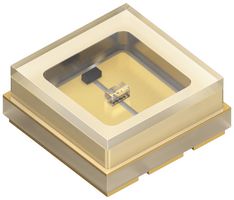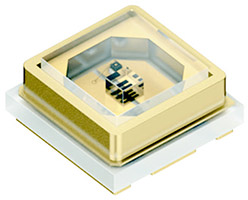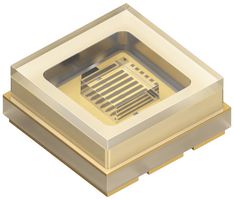
UV-C treatment: the hygiene gamechanger
LIGHTS ON, GERMS GONE
Did you know that ultraviolet light is a chemical-free, efficient sanitizer?
Advanced UV-C solutions make purification easy and accessible, for private, business and public spaces. Miniaturization enables the integration of highest-efficiency UV-C LEDs and presence detectors in public and home appliances:
embedded in standard light sources to sanitize public spaces, in purification boxes to purify handheld devices or in taps to purify water. Intelligent air filter systems use ams OSRAMs UV-C LEDs in combination with matching spectral sensors to determine the quality of air with respect to organic pollution. This allows to realize innovative extensions to systems, e.g. for air conditioning: The combination of UV-C LEDs and spectral sensors enable advanced predictive maintenance solutions for e.g. filter replacement or detection of critical contamination levels w/ spores, fungi or bacteria.
Applications
- Horticulture Treatment
- UV-C Treatment
- Sensing
What is UV-C radiation?
The sun emits optical radiation in form of visible and invisible light. We humans define light as what we can see from the visible spectrum of light, that is, the wavelength between violet (400nm) and dark red (800nm). For the use of light against viruses and germs, the focus is on the range below 400 nanometers, the so-called UV radiation. UV light is divided intro three ranges: UV-A, UV-B and UV-C. The wavelength decreases progressively from 400 to 100 nanometers. Category A ultraviolet sunlight reaches the earth almost unfiltered. UV-A radiation penetrates deep into our skin and causes it to age. UV-B light reaches our upper skin layers and is responsible for sunburn. The short-wave, particularly high-energy UV-C radiation from the sun, on the other hand, is completely absorbed by or ozone layer. There is therefore no natural UV-C radiation on earth. Life on earth has thus developed without being exposed to UV-C radiation. In other words: There was simply no need to develop natural defense mechanisms against UV-C light. This opens special possibilities for science, medicine and technology.
UV-C photons with a wavelength of 200 to 280 nanometers have sufficient energy to alter microbial DNA meaning the exposure to the electromagnetic radiation modifies the genetic material of microorganisms and disrupts their ability to reproduce. As UV-C radiation attacks the helix structure of DNA and RNA it is also effective to inactivate multi-resistant pathogens.
How does it work?
For the use of light to inactivate pathogens, the focus is on invisible light below 400 nanometers, the so-called UV radiation, in particular the Category C ultraviolet light. Although both UV-B and UV-C can harm cells and hence have the capability for sanitization, the extent of the molecular rearrangement of the DNA / RNA by these two radiations is very dissimilar. The shorter the wavelength as more effectively light can penetrate the cells of Microorganisms, therefore UV-C is more suitable to neutralize pathogens. UV-C radiation triggers a photochemical reaction. Depending on the doses of the absorbed UV-C light it modifies the DNA / RNA helix strands by thymine dimer formation, disrupting the pathogen’s capability to replicate and render it harmless.
Why is it so important?
Clean water. Clean air. Clean surfaces. A pure environment where health and safety for everyone is made possible even under the harshest conditions.
In an interconnected world, new challenges arise such as we have recently been witnessing to. We are confronted with pathogens every day. At home and at work, from running an errand, to seeing a physician or the use of plain tab water. The COVID-19 pandemic has led to a heightened sense of awareness for disinfection and with it a desire for effective UV-C solutions.
UV-C radiation effectively reduce harmful microorganisms without the use of chemicals.
Products
100mW OSLON® UV 6060
- Package: Ceramic package with lens
- Chip technology: AlGaN based flip chip
- Typ. Radiation: 150°
- Color: λpeak = 265 nm (● ultraviolet (UV-C))
- ESD: 2 kV acc. to ANSI/ESDA/JEDEC JS-001 (HBM)
- Radiant Flux: typ. 100 mW
- Radiant Efficiency: typ. 5.7 %

4.7 mW OSLON® UV 3636
- Package: Ceramic package with integrated glass cover
- Typ. Radiation: 120° (Lambertian emitter)
- Color: typ. λpeak = 275.0 nm (● ultraviolet (UV-C))
- ESD: 2 kV acc. to ANSI/ESDA/JEDEC JS-001 (HBM)
- Radiant Flux: typ. 4.7 mW
- Radiant Efficiency: typ. 2.6 %

13.5 mW OSLON® UV 3636
- Package: Ceramic package with integrated glass cover
- Chip technology: AlGaN based Flip chip
- Typ. Radiation: 120° (Lambertian emitter)
- Color: λpeak = 275 nm (● ultraviolet (UV-C))
- ESD: 2 kV acc. to ANSI/ESDA/JEDEC JS-001 (HBM)
- Radiant Flux: typ. 13.5 mW
- Radiant Efficiency: typ. 2.4 %

42 mW OSLON® UV 3636
- Package: Ceramic package with integrated glass cover
- Typ. Radiation: 120° (Lambertian emitter)
- Color: typ. λpeak = 275.0 nm (● ultraviolet (UV-C))
- ESD: 5 kV acc. to ANSI/ESDA/JEDEC JS-001 (HBM)
- Radiant Flux: typ. 42 mW
- Radiant Efficiency: typ. 2.1 %

